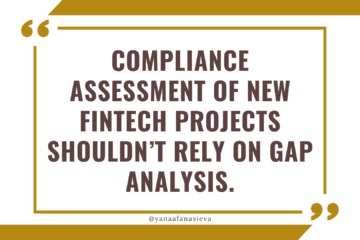Why is Compliance Function Underpaid?
One of the biggest complaints I hear from fellow compliance professionals is about being underpaid. The second biggest complaint is about a lack of appreciation for what they do.
It’s true that at the same level and with approximately the same level of seniority, it is more likely that compliance experts would be paid significantly less than someone from sales, finance, or engineering. Bonuses, salary increases, even the budgets for corporate events and team building activities are lower comparing to what you would “normally” see within sales, business development is other “revenue-generating” teams.
Do you want to know why?
My theory is that neither the business side nor the compliance side has a good financial model to quantify compliance input. People don’t know what value to assign to clean audits or risk ratings or due diligence checks. Unfortunately.
Everyone just defaults to stereotypical phrases such as that compliance is a “necessary evil” and “unavoidable burden” – which is why the function ends up being “underpaid”.
I have met a number of compliance executives at large companies who openly told their employees and teams that “we will never be as valued as sales or engineering, this is just how things are, we bring our knowledge and expertise, we are good professionals, but we are not here to bargain for bigger bonuses, the best reward for your good work is just more work…”
When I became a consultant, I had no other option but to learn how to price my services, and having a CPA, MBA and M&A background in addition to understanding compliance obviously helps. ☺️
My company’s revenues have steadily increased over the last years and this year is about to double, which is clear evidence that I can articulate and justify the value added by compliance (otherwise people would not pay me, right)?
And you know what is the worst possible argument to justify the price (which I never ever use) where almost everyone else gets it wrong? – It’s to say that something is required by law.
If your argument is “this is required by law”, your CEO or a founder immediately will tell you “what is the minimum of the minimum required by law” and you downgrade yourself and your function in their minds. If they don’t see the value and your only argument “it’s a cost required by law”, in their mind the cost of compliance will be associated with something similar to paying taxes and social security.
There is no way around: if you want to get paid and get resources and appreciation you deserve, you should be able to calculate and articulate your commercial value for the business, and then deliver.
It is not enough when the CEO appoints their new CCO or a Head of Compliance and announces that this person will be their “trusted partner” and compliance from now on is going to be “the most important stakeholder”… Almost nobody believes that, frankly. And the lower and more granular you go down the compliance hierarchy, the more resentment, disappointment, and disillusionment you find around the work done by compliance teams and how it’s been perceived.
Another interesting explanation I often hear from my compliance peers on why they accept being underpaid is “I’m not good with numbers” and “I hate marketing and “self-promotion”…
This is why I’m trying to do something different about it since I’m really good with numbers and I understand marketing…
If you want to learn how to calculate and justify this value for your business stakeholders using just one example, then I’d like to invite you to join a Workshop on How to Onboard Corporate Customers and Review Complex Legal Structures.
Why your business stakeholder should pay (and pay attention)? – Because onboarding of corporate customers is the most painful and heated compliance areas, most time-consuming and conflict-inducing. If you don’t figure this out for your company, it’s hard to be appreciated for anything else, because it’s the most visible area and also the easiest to quantify.
I designed this workshop around pragmatic risk acceptance decisions and cost-benefit analysis, which is why, if you decide to join, not only will you learn about the latest industry-specific risk indicators and red flags and corporate structures, but – MOST IMPORTANTLY – you will see how to quantify risks and risk acceptance decisions and clearly demonstrate the value added by or lost in your onboarding flow.
Curious? – Sign up here!


